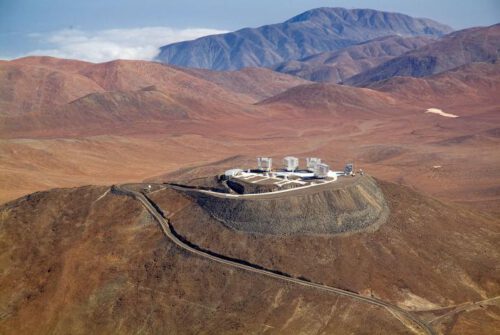When building the next giant telescope in the Atacama Desert in Chile, changes in winds and visibility as a result of global warming must be taken into account, even in the most remote areas, especially when planning a facility that will operate for about a century

Image: J.L. Dowburn & G. HÜDEPOHL (ATACAMAPHOTO.COM)/ESO The rising temperatures at the observatory affect the quality of the images.
We are all familiar with the phenomenon of light pollution that interferes with making astronomical observations from populated areas, so it turns out that even if you move away to the most isolated place in the world you are still not protected from interference.
Climate changes related to global warming can also affect the quality of astronomical observations. This is the conclusion of an international study led by scientists from the University of Cologne.
The international research team investigated a variety of climatic parameters at the Very Large Telescope (VLT) located at Parnal in the Atacama Desert in Chile, where the European Southern Observatory (ESO) operates its telescopes. Among other things, the team members examined the temperature data, wind speed and direction, and the water vapor content in the atmosphere over a period of several decades. The measurements revealed an increase in the average global maximum temperature as well as an increase in the blurring of astronomical photographs due to the formation of air vortices.
The study, titled 'The Impact of Climate Change on Astronomical Observations', was published in the September 10 issue of the journal Nature Astronomy. Its results are important not only for astronomers when they come to adapt their observations to the changing environmental conditions, but also to take them into account when planning new large telescopes - such as the Giant Telescope (ELT), currently being built near Parnal.
Professor Susan Kroll and Christoph Boehm from the Institute of Geophysics and Meteorology at the University of Cologne were involved in the research. They have already studied various aspects of the climate in the past, present and future at the telescope site as part of the 1211 Collaborative Research Center 'The Earth - Evolution at the Limit of Ground Observation'. The paper's first author is Faustin Antlos from the Max Planck Institute for Astronomy in Heidelberg.
The researchers studied the extent of the impact of climate change on the quality of the observations. The team focused on the Paranal Observatory in northern Chile because it houses a wide variety of environmental sensors that record local meteorological conditions. These measurements produced one of the most comprehensive data sets in the last three decades in an area where almost no measurements were made.
Based on this dataset, astronomers, climatologists, atmospheric scientists and meteorologists joined forces to identify important meteorological parameters that play a role in the quality of astronomical observations. The data allowed them to analyze long-term trends over a period of more than thirty years to determine the impact of climate change on future observations. They showed, through four examples, how climate change is already affecting, or may affect the operation of astronomical observatories in the future. The VLT, operated by ESO, was used as an example.
"The data showed an increase of 1.5 degrees Celsius in the ground temperature in the last four decades at Parnal Observatory. This is a slightly higher increase than the global average of 1 degree Celsius since the pre-industrial era," said Susan Carroll. Because the telescope's original cooling system was not designed for such hot conditions, the quality of the observations is at increasing risk of deterioration due to more frequent turbulence - a result of the rising temperature. The expected increase of 4°C (the ICCP's most pessimistic scenario) in the next hundred years must be taken into account in the construction of the 39-meter giant telescope (ELT) at a nearby site.
In particular, astronomers are faced with the challenge of reducing the so-called "dome seeing", a decrease in resolution due to turbulence inside the telescope's dome. The researchers noticed it in addition to an increase in turbulence in the air layer near the ground, which makes the images blurry because cold and warm air layers with different refractive indices alternate rapidly. This phenomenon appears when atmospheric turbulence conditions change faster than the telescope's control system can correct. This limits the contrast capabilities of the instrument and may limit studies that require high sensitivity such as searching for planets outside the solar system.
From their unique perspective on the universe, astronomers know that the development of life on Earth was a complex process made possible only by the coincidence of extremely rare circumstances. There is no second Earth in our neighborhood. For this reason, the latest issue of Astronomical Nature published on September 10 is dedicated to the topic of climate. The special issue is designed to raise awareness of the climatic aspects important to the work of astronomers.
to the notice of the researchers
More of the topic in Hayadan:
- A rare direct photograph of planets around a sun similar to ours (from a telescope in the Atacama Desert)
- The giant European telescope is on its way - the biggest eye in the sky
- Climate and desert
